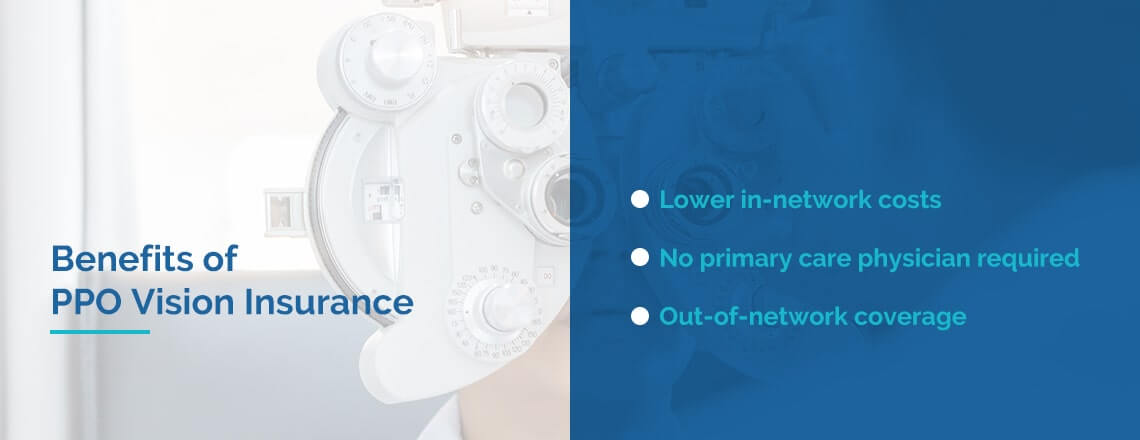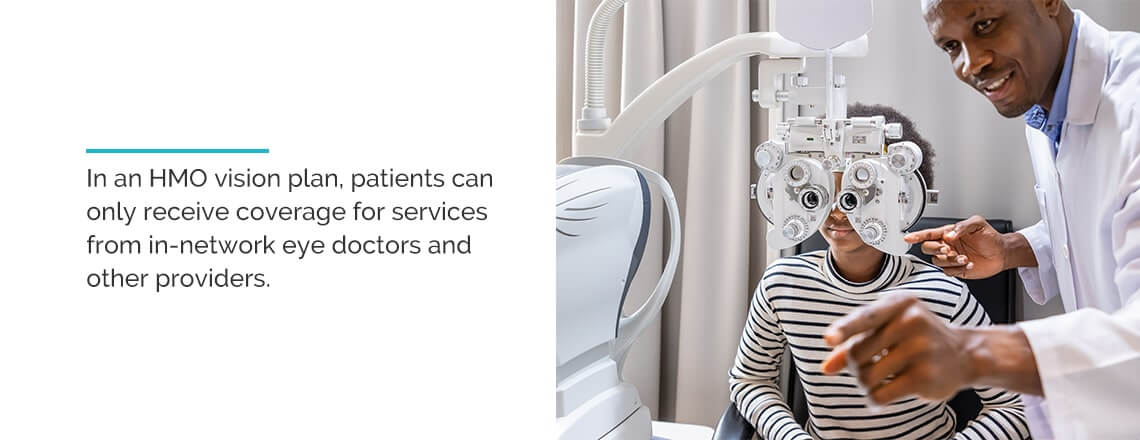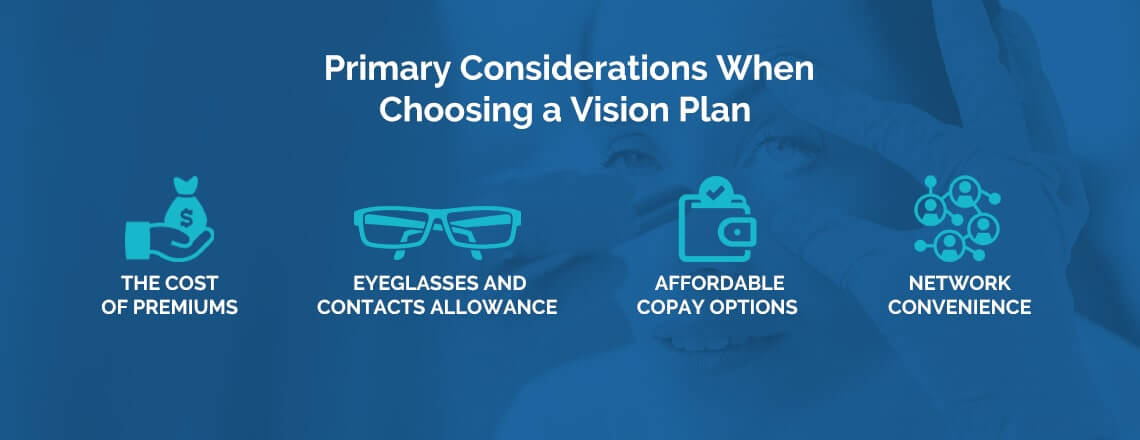
Many people in California purchase dental and vision insurance through an employer-sponsored or individual plan. Regular visits to the optometrist can catchcommon eye diseaseslike glaucoma and diabetic retinopathy and help preserve your vision.
People who wear glasses or contacts especially recognize the importance of affordable vision care. According to statistics from 2019, the average cost of eyeglasses frames was$231 per pair. Having adequate vision coverage significantly lowers the cost of eye exams, preventive and diagnostic services, glasses and more. Regular eye exams can also detect emerging issues like diabetes and high cholesterol.
Several vision insurance plans are available to California residents, including vision benefits and discount vision plans. Discover the types of vision insurance for California residents to determine which plan is right for you.
Preferred Provider Organization Vision Plan
The Affordable Care Act requires all health plans offered in the Marketplace to include10 essential health benefits, including services like mental health care, pediatric dental and vision, hospitalization and the cost of prescription drugs. However, the ACA does not mandate vision care for adults. Some health plans include vision coverage for adults, though this varies among insurance companies and plans.
When adding vision insurance to your health coverage, you can purchase supplemental insurance or a stand-alone vision plan that makes up for anything your employer-sponsored or individual plan lacks. These vision benefits plans are one of the two primary types of vision coverage available to California residents.
Most vision benefits plans are preferred provider organization plans. A PPO vision plan provides a network from which patients can choose their providers. The network includes optometrists, physicians, hospitals and other providers whose services are under the policy. When you sign up for a PPO vision plan, you pay a monthly premium to receive coverage for various vision care services, including:
- Annual eye exams
- Eyeglasses frames and lenses
- Contacts
- Diagnostic tests

Benefits of PPO Vision Insurance
Many patients select PPO policies for their California vision insurance because they bring several benefits.
- Lower in-network costs:Receiving vision care services from the eye doctors within your PPO plan’s network will typically cost you less than if you visited an out-of-network provider. A PPO plan also provides cheaper vision care services than if you were uninsured.
- No primary care physician required:PPO plans don’t need patients to have a PCP. This type of plan allows you to see a doctor or specialist without visiting your PCP if you have one, so patients can go straight to the provider they want.
- Out-of-network coverage:Although visiting an in-network provider is usually less expensive, patients with a PPO vision plan can go to an out-of-network eye doctor.
Disadvantages of PPO Vision Insurance
Despite the benefits of PPO vision insurance, this coverage may not suit everyone’s needs. People who want vision coverage may consider the potential drawbacks of PPO vision plans.
- Limited provider options if you want maximum coverage:PPO plans offer the most coverage for services within a specific provider network. If a patient chooses to receive vision care from a provider outside the approved network, they will pay a higher percentage of the cost and receive less coverage. Out-of-network providers could cost a patient higher deductibles or nondiscounted charges.
- Higher premiums:The cost of any vision insurance plan differs between insurance companies and policies. However, PPO vision insurance plans tend to have higher monthly premiums than other plans because they offer more flexibility. PPO vision plans may also require patients to pay more out of pocket for eye exams, glasses and additional costs. A higher deductible is especially likely if the patient visits an out-of-network provider.

Health Maintenance Organization Vision Plan
Health maintenance organization vision plans are the other option available to California residents. In an HMO vision plan, patients can only receive coverage for services from in-network eye doctors and other providers. These providers are part of the health maintenance organization for the patients in the network, hence the plan’s name.
HMO plans also require monthly premium payments, though there is typically no deductible or a low one. People with HMO vision insurance can take advantage of the same vision care services as those with PPO insurance, including:
- Annual eye exams
- Diagnostics
- Glasses frames, lenses and contacts
HMO vision insurance for California residents differs from PPO insurance in several notable ways.
- The necessity of a PCP:Unlike a PPO vision plan, which never requires patients to have a PCP, many HMO plans require PCPs. Typically, patients must visit their PCP before seeing other providers or specialists. The PCP coordinates additional visits if necessary and can refer patients to specialists for their unique needs.
- Breadth of coverage:An HMO vision plan only covers out-of-network care in the case of an emergency, so people with this type of plan need to be sure to visit in-network eye doctors if they want covered vision care.
Benefits of HMO Vision Insurance
Whencomparing HMO and PPO plans, people interested in getting vision coverage could benefit from some of the unique characteristics of an HMO plan.
- Lower premiums:Whilelow deductible health plansoften have higher premiums, the premiums for HMO plans are generally lower than those for PPO plans.
- Low or nonexistent deductibles:HMO plans usually have a low deductible, if they have one at all.
- PCP schedules additional services:Since the PCP determines whether patients need specialist treatment, patients receiving vision care won’t need to worry about finding an eye doctor.
Disadvantages of HMO Vision Insurance
HMO vision plans might also come with a few downsides.
- Need for a PCP:To enroll in many HMO plans, patients must select a PCP from the provider network who will coordinate their vision care.
- Little opportunity to go out of network:While PPO plans allow patients to visit out-of-network providers and potentially pay a higher cost, HMO vision plans usually don’t offer coverage for services from providers outside the plan’s network.
- Service area requirements:Many HMO vision plans might only apply to limited geographic areas. People interested in an HMO vision plan should check to ensure they work or live in its service area.
- More restrictions:Some HMO plans include more coverage restrictions than PPO plans. These limitations might only allow patients to receive a specific number of eye exams, tests or treatments per year.

Primary Considerations When Choosing a Vision Plan
Selecting any health care plan requires careful consideration of all your options. The type of plan a patient chooses impacts the cost of a wide range of services. People searching for vision insurance for California residents should consider several factors when comparing plans.
1. The Cost of Premiums
It’s understandable to want to minimize costs, especially if you have relatively healthy eyesight now. However, paying as little as possible in monthly premiums often means you receive less coverage. When you need vision care, you want adequate coverage for the necessary screenings and services.
When comparing plans, it’s essential to balance cost with coverage. Most vision insurance companies offer competitive premium pricing for comparable coverage. For instance, higher premiums might come with a more generous allowance for new glasses. Consider what benefits are worth paying extra to have.
2. Eyeglasses and Contacts Allowance
Vision insurance typically helps people pay for one eye exam and one pair of eyeglasses or supply of contact lenses per year. These plans vary by eyewear allowance. Many vision insurance plans cover frames, lenses and contacts up to a specific dollar amount and provide an additional discount off the balance.
If you prefer to have multiple pairs of glasses, are prone to breaking frames or want a more expensive style, you may want to consider a plan with a more substantial frame allowance. California residents can choose avision plan from VSP or EyeMedthrough Covered California and receive a significant frame allowance of between $120 to $200 depending on the policy, plus discounts on additional frames or LASIK surgery.
3. Affordable Copay Options
Some visioninsurance plans have copays, while others have coinsurance. The expenses a plan covers vary widely, so examining your vision plan options and comparing costs is essential. Some plans may only charge copays on lens enhancements, while others charge a $10 copay at the time of your eye exam. When determining whether a plan’s out-of-pocket costs are affordable for you, compare monthly premiums and copays with the coverage you receive.
For example,VSP offers two plans, one with a $120 eyewear allowance at a monthly premium of $15.16 per person. The other plan provides a $175 allowance at a monthly premium of $19.24 per person. EyeMed monthly premiums for California residentsrange from $5for one person on the Healthy plan to $90 for three to nine people on the most comprehensive Bright plan.
4. Network Convenience
While PPO and HMO vision plans both have networks, PPO plans offer greater flexibility in coverage for out-of-network providers and eye doctors.
For example, VSP’s extensivenetwork of 5,092 doctorsacross California makes this vision insurance ideal for many Californians. If you go out of network, theVSP individual plan limitsthe coverage members can receive for out-of-pocket costs. If you have this plan and choose to go out of network, you can expect to pay most of the full cost per visit.
Frequently Asked Questions About Vision Insurance
Coverage details vary among insurance companies and plans, so people interested in getting vision insurance should look at their plan options to answer specific questions. Consider these FAQs about vision insurance for California residents that might answer some of your general questions.
Do I Need Vision Insurance?
Many people don’t need vision services or corrective lenses, but a large percentage of the population does. For example, an estimated45 million peoplein the United States wear contact lenses. Vision insurance financially benefits those who wear glasses or contacts. For example, vision insurance may enable patients to payless than half the priceof vision care per year, compared with those who are uninsured. Some vision plans also offer significant discounts on corrective surgery like LASIK.
Some people may look into discount vision plans as an alternative to insurance. Discount vision plans require members to pay a fee for a reduced cost on many types of vision care. However, these plans don’t provide the same comprehensive coverage as vision insurance.
How Do I Get Vision Coverage for My Kids?
The ACA considers vision insurance for kids anessential health benefit. All Covered California health plans include this coverage. However, if you want vision insurance for yourself or the other adults in your family, you’ll need to add supplementary vision insurance to your plan.
What Does Vision Insurance Cover?
The services covered by a vision plan vary between insurance companies and policies. Read each policy carefully to determine what it does and doesn’t cover. Most vision insurance plans will provide a measure of coverage for the following services:
- Annual eye exams
- Eyeglasses frames and prescription lenses
- Prescription contact lenses
Some policies may also include coverage for progressive lenses, LASIK surgery and anti-reflective coating for eyeglasses. Vision insurance also typically comes with price limits on frames and excludes many types of eye surgeries and other treatments.
Who Can Enroll in Vision Insurance?
Vision insurance in California is available for people aged 18 and older who are lawful residents of the state and have a Social Security number. People may choose a stand-alone plan or supplementary coverage for their family plan. You can enroll in vision insurance year-round and do not need health insurance to receive vision coverage.
Are Vision Care Expenses Tax-Deductible?
If you have unreimbursed vision care costs, you may be able to deduct the expenses from your taxes. Taxpayers candeduct qualified vision care, glasses and contacts expenses if their insurance doesn’t cover the total cost. Some premiums are also eligible for a tax deduction, plus other costs associated with receiving vision care, like travel expenses.
Find the Right Health Insurance Plan for You at Health for California
Having adequate vision care is essential for maintaining your vision health and reducing out-of-pocket costs for prescription glasses, eye exams and more. At Health for California, we strive to provide people with a straightforward experience when finding a health insurance plan that fits their needs. Our insurance application process is free, easy and accurate, so you know what kinds of coverage options are available to you.
Health for California agents are conveniently available to answer your questions and offer help.Request a quotefor health insurance to find a plan today.